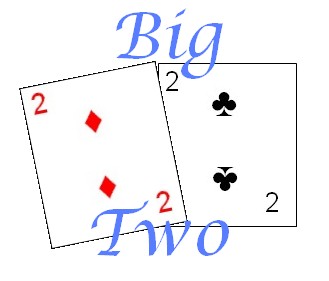
Big Two is an exciting game for four players which originated in China and quickly spread around the world due to its fun and addicting gameplay.
There are also variations of Big Two for 2 or 3 players described in the variations section below, along with a number of other changes or versions of Big 2 that may be encountered.
As this game has spread rapidly and is played in a great number of different locales (such as in the Netherlands as Sjalaliién), it is also found by a number of different names including Big Deuces, Da Lao Er, Top Dog, Sho Tai Ti, and Choh Dai Di.
Players, Deck and the Deal
This game uses the standard deck of 52 cards which rank in the following order, from highest to lowest; 2, Ace, King, Queen, Jack, 10, 9, 8, 7, 6, 5, 4, 3. In addition to this ranking by denomination, the suits are also ranked in the following order, also from highest to lowest; Spades (♠), Hearts (
♥), Clubs (♣) then Diamonds (
♦). This suit ranking usually comes into play when cards of identical rank are played.
The ultimate objective of Big Two is to be the first player to get rid of all his cards.
The dealer can be determined using any of the standard methods, with cutting for high card a very common method. The ranking of the cards is identical to that given above for ranking of cards in the game. If two or more players cut cards of the same numeric ranking, the suit ranking is further used to determine the highest card.
Once the dealer is determined the dealer would shuffle the cards and offer the deck to the player to his immediate left for the cut. If this player declines the cut, the dealer himself should perform the cut.
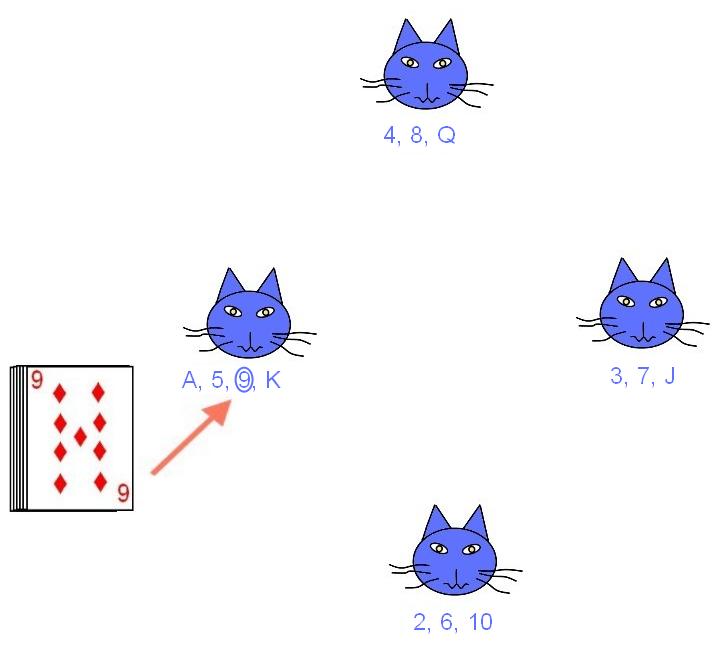
|
A nine pulled would end up resulting in the dealer himself receiving the first card dealt. |
|
After cutting, the next order of business is to determine which player will actually receive the first dealt card.
This is done by pulling a stack of cards from the deck and turning it over, showing only the bottom most card of this stack.
After making note of the number shown, the removed stack, including the displayed card is carefully placed back onto the stack so as not to disturb the original ordering of the deck. The number which was displayed is then used to determine the player who will get the first dealt card. The dealer then begins counting, starting with himself in a counter-clockwise direction around the table. He would continue to count one by one around the player until reaching the number of the revealed card. The person who the count stops at will be the player to receive the first card of the deal. Jacks would be equivalent to a count of 11, Queens 12, Kings 13 and Aces 1.
The dealer then begins dealing the cards in a counter-clockwise direction, starting with this player. Each player will receive one card face down in front of him. The dealer continues dealing in this manner around the table until each player has 13 cards on the table in front of him.
The winner of each hand becomes the dealer for the next hand, using the same procedures described to determine who receives the first card in the next deal.
Play of the Hand
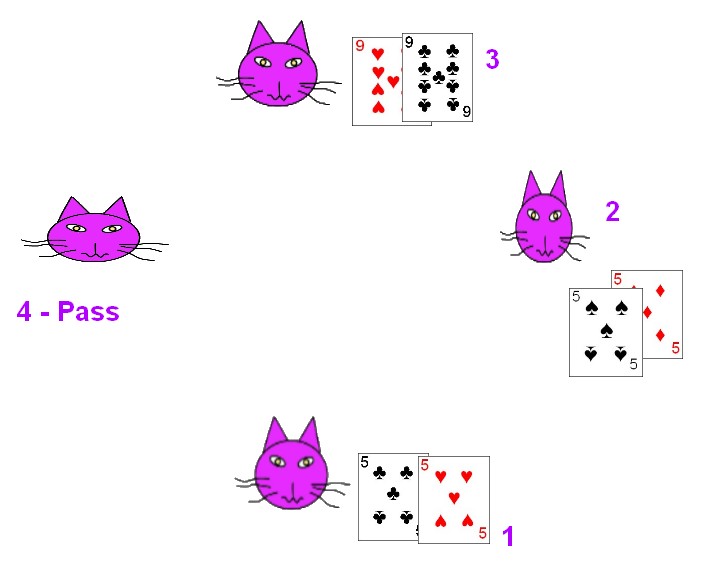 |
| In this example, player 1 plays a pair, Player 2 beats this pair (by suit). Player 3 then beats the last pair with a higher numbered pair. Player 4 subsequently passes, not able or choosing not to beat the pair of 9's. |
After the cards are fully dealt, play begins. The player who holds the Three of Diamonds must play first and must play this card, either solo or in some legal combination (see legal plays below) in his first play.
After this player plays, the turn rotates around the table in a counter-clockwise direction from player to player. The next player in turn attempts to play a higher combination of cards than that previously played to the table. If he does not have (or does not want to play) such a combination, he passes, and the turn moves to the next player in turn who attempts to beat the combination. Cards are played face up to the center of the table such that all players can clearly see the card or card combination played. This will create a growing pile of cards in the center of the table as the players continue to make their plays. Play continues around the table from player to player, each attempting to play a higher combination of the same number of cards than that previously played. When attempting to beat a previous card or combination, the higher combination played must consist of the same number of cards as the combination previously played.
Once three consecutive players pass (not able or not wanting to play a higher combination of the same number of cards), the entire pile of cards in the center of the table is usually set aside. Then, the individual who last played the highest combination starts the cycle again by playing any card or legal card combination to the center of the table. Since he is starting a new series of plays, the combination he plays may consist of any legal number of cards. As before the players in turn then attempt to play a card or combination that can beat the last played. Having passed, a player is not forced to pass on his next turn and may elect to play the next time it is his turn.
At any time during the game a participant may ask any other participant how many cards they have left in their hand. The player asked must give an accurate answer.
Legal Combinations
The following shows the complete list of allowable combinations, grouped as to the number of cards in the combination. A player may only play a higher combination consisting of the same number of cards. For example, a three card combination may only be beat by a higher three card combination.
| Cards in Combination | Description | Example |
|---|
| 1 | A single card combination consists of just one solo card. These use the ranking of cards as described above when being compared. A card of the same denomination but a higher ranking suit will beat a card of the same denomination of a lower ranking suit. | 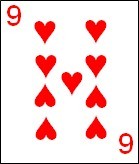 |
| 2 | Two card combinations always consist of a pair of cards of the same denomination. A pair of higher denomination cards will beat that of a lower denomination. A second pair of the same denomination can beat the previously played pair if one of its cards is of the suit of spades (the highest ranked suit). | 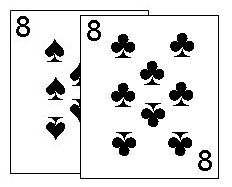 |
| 3 | This will always consist of three cards of the same denomination. Three cards of a higher denomination beat a triplet of a lower denomination. | 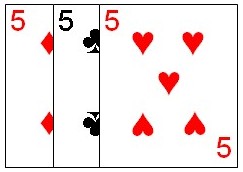 |
| 5 | There are a number of legal five card combinations which are ranked in the following order, from lowest to highest:
- Straight:
A straight consists of five cards of consecutive denominations (i.e. 8, 9, 10, Jack, Queen). They do not have to all be in the same suit, as if they are, this would be considered a higher ranking straight flush. In order to beat another straight a straight must contain a higher denomination card. A straight containing all of the same ranked cards can also beat a previous straight if the suit of the highest ranked card in the suit is of a higher ranked suit. Aces can be used as either the top card of a straight (10, Jack, Queen, King, Ace) or the bottom card of a straight (Ace, 2, 3, 4, 5). Notice also that twos appear in their normal ordering before the 3 when used in a straight.
- Flush:
A flush consists of five cards all of the same suit. The cards do not need to be in consecutive order (otherwise it would be a higher ranked straight flush). For comparison of two flushes, the flush which is in a higher ranked suit beats any other flush, regardless of the actual denominations of the cards in the flush. With two flushes of the same suit, the flush containing the highest ranked card would be considered the higher (with the 2's being considered the highest ranked cards in the deck).
- Full House:
A full house is five cards which consists of three of a kind and a pair. A full house can beat a previous full house if the three of a kind is higher than the three of a kind in the previous full house.
- Four of a Kind (plus an odd card):
This five card combination consists of four numerically identical cards and then any fifth card. When comparing a similar combination, the higher denomination four of a kind is considered higher ranking.
- Straight Flush:
A straight flush is five sequential cards, all of the same suit (i.e. 5, 6, 7, 8, and 9, all of hearts). When comparing two such straight flushes, the one containing the highest card is considered the higher ranked. If two straight flushes contain the exact same denomination cards, the one in a higher ranked suit is considered the higher straight flush.
| 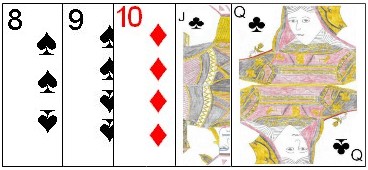
Straight | 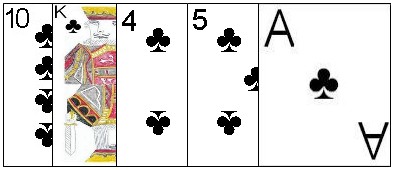
Flush | 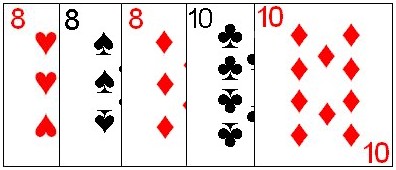
Full House | 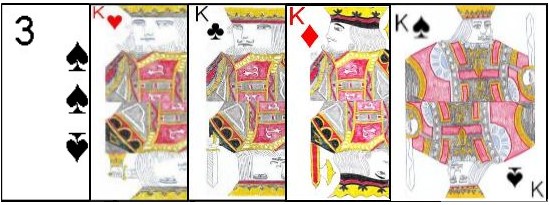
Four of a Kind with Odd Card | 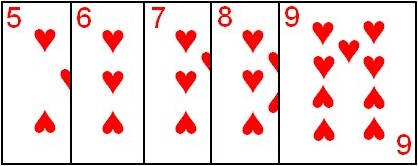
Straight Flush |
|
As mentioned any combination can only be beaten by a combination containing the exact same number of cards. As there are multiple types of five card combinations, any higher ranked type of five card combination will beat a lower ranked five card combination, and five card combinations of the same type usually have a relative ranking based on the cards comprising the combination.
Winning the Game
The first player to play his last card to the center of the table is immediately declared the winner of the hand. The remaining players are assessed a penalty based on the number of cards they have remaining in their hands as follows:
| Cards Remaining in Players Hand | Points Per Card |
|---|
| 9 or less | 1 |
| 10 to 12 | 2 |
| 13 | 3 |
Big Two is often played until one player reaches some pre-determined score (such as 100), at which time the player with the lowest score is declared the game winner. Alternatively, no points are carried over from hand to hand with each individual hand considered a complete game.
Since Big Two is a game played in a wide range of geographical locales, a large number of variations or rule differences can be found. Below a number of these variations are described.
Many of the common of the variations are based on differences in allowable plays and ranking of such plays.
Pusoy Dos: This is a variant of Big Two which is widely played in the Philippines. In Pusoy Dos the ordering of the suits is modified. The ranking of the suits in this version is, from high to low; Diamonds, Hearts, Spades and then Clubs. The player who holds the three of clubs is the first to play. Additionally, in Pusoy Dos, the scoring is somewhat different. The first player to run out of cards would score 1 point while all other players score 0. However, if the winners last combination played includes any twos, he can score significantly more points as per the following chart:
| Number of Twos in Last Combination Played | Total Score Earned for the Hand |
|---|
| 1 | 2 |
| 2 | 4 |
| 3 | 8 |
| 4 | 16 |
The first player to reach some pre-designated number of points (such as 20) would be declared the winner.
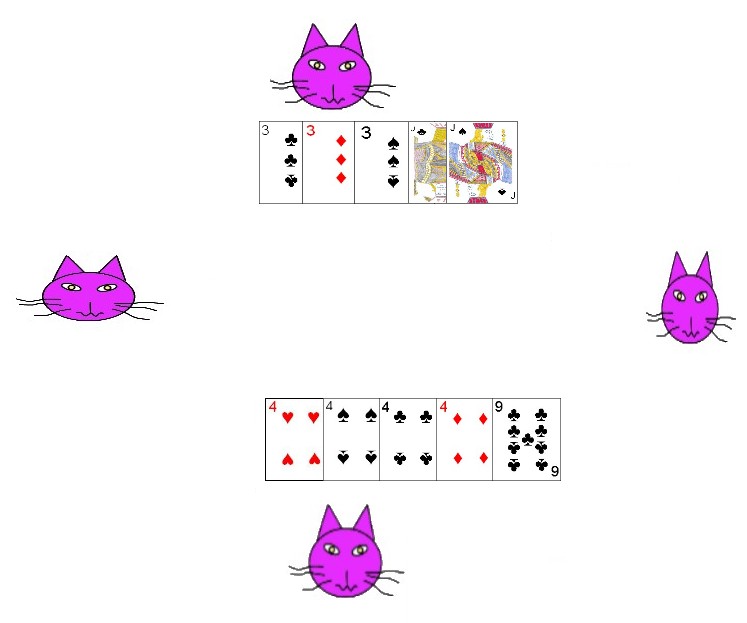 |
| In Bu Bu Gao Sheng, certain 5 card combinations can be played out of turn. |
Bu Bu Gao Sheng: This variation is played identically to the standard game of Big Two with several exceptions:
In Bu Bu Gao Sheng, flushes are not valid combinations and cannot be played. Full houses are allowable plays, but are considered lower rank than a straight, thus the ranking for five card combinations in Bu Bu Gao Sheng is (from low to high): Full House, Straight, Four of a kind (with odd card), Straight Flush.
In addition, Bu Bu Gao Sheng allows a player to play certain five card combinations out of turn. Thus, if a player holds a valid four of a kind five card combination or a straight flush combination that can beat the currently played five card combination, he may immediately play it to the center, out of turn. If two players attempt to do so at the same time, the first combination to hit the table is considered the first played. Scoring is also somewhat different. The winner receives 1 point per card for each card left in an opponents hand if they have 10 or less cards, and 2 points per card if the opponent has 11 or more cards remaining in their hand.
Play Continuation: In some variations of Big Two, the game does not end when the first player runs out of cards but continues until there is just one player with cards remaining. When a player plays his last card in a legal play, he simply waits out the remainder of the hand. This continues until only one player has cards remaining, who has been defeated by all the other players. When a player plays his last card, and none of the remaining players with cards are able (or want) to beat the combination, the opportunity to start with a new card or combination goes to the next player in turn who has cards remaining.
Simplified Dealing Procedures: In some games, the normal procedures for determining which player receives the first card in the deal are removed. In these instances, the player to the immediate right of the dealer would receive the first card, with the deal continuing in the normal counter-clockwise rotation used for this game.
Big Two for Two Players: A two player version of Big Two is also often played with rules very similar to the four person version. Different variations for two players call for each player to receive differing numbers of cards, but one of the more common variations has both players receiving 21 cards with the remainder of the deck set aide, unused in the rest of the hand. The player who holds the lowest card plays first, using this card in some combination. Since it may not be readily apparent who holds this lowest card, the players can start with one player announcing the lowest card (i.e. three of diamonds), and a player states whether he has that card, and if so, can then proceed to make a first play. If no player has that card, the player would then announce the next lowest card in the deck (i.e. four of diamonds), and if either player has it they would announce this and then make an appropriate play. This could continue until the lowest card in the deck was discovered, with play then continuing as normal. All other rules are played identically to the standard four player version of Big Two including the scoring. If a player holds more than 13 cards when his opponent plays his last card that player would be assessed a 3 point penalty.
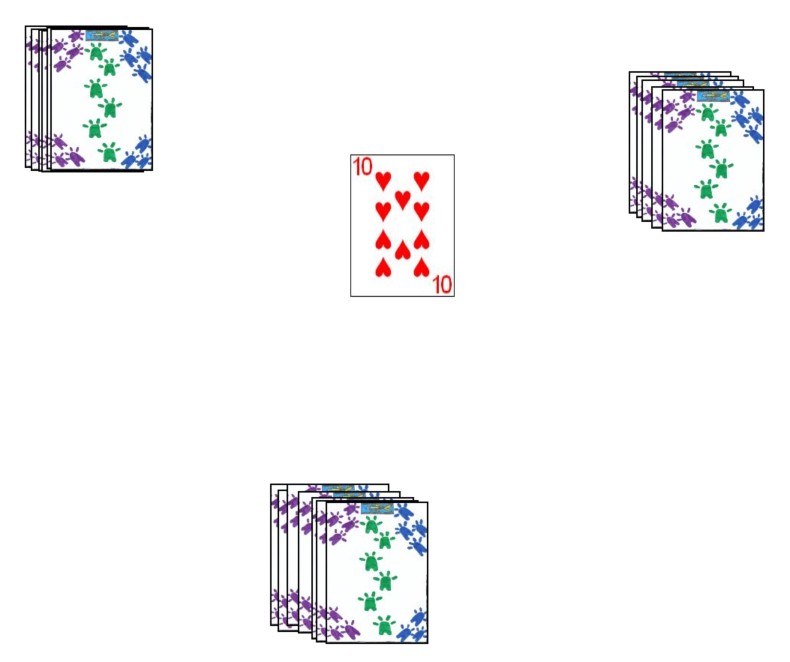 Big Two for Three
Big Two for Three: Big Two is also widely played with three players in a variation similar to that for two players. When three participants are playing, each player would receive 17 cards and the last card is dealt face up to the center of the table. Whichever player holds the three of diamonds would then take this card up into their hand. If that last card happens to be the three of diamonds, the holder of the three of clubs would take the card. The player taking this card would then start by making the first play (which must include the three of diamonds). The remainder of the rules are identical to the standard four hand game including in the scoring. If a player has more than 13 cards remaining in his hand when the winner of the hand plays his last card, he would be assessed a penalty of 3 points.
Alternate Flush Ranking: In some games, players will rank flushes first based on the highest card contained in the flush (with twos considered the highest ranked card in any suit) rather than using the suit of the flush as the primary ranking mechanism. The suit of the flush is only used if the flushes contain all cards of the same denominations.
Twos in Straights and Straight Flushes: Another ranking change sometimes used in Big 2 is regarding straights and straight flushes containing twos. In the standard version, a straight containing the two (i.e. 2, 3, 4, 5, 6) is ranked based on the highest card in the straight (i.e.. 6) while one variation states that the 2 is considered the highest card in the flush (although it occurs at or near the bottom of the sequence).
Additional Penalties for Twos: Another variation of Big Two that is sometimes encountered regards additional penalties applied to a holder of unplayed twos at the end of a hand. Using this rule, a player is penalized an additional one point for each 2 they are found to have remaining in their hand.
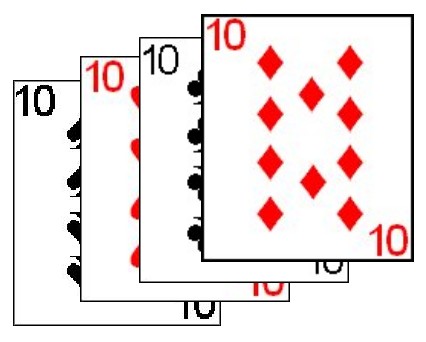 Quads
Quads: In some versions of Big Two, quads are played without the addition of the fifth odd card. Thus, a new, four card combination is added to the game. A quad is four cards of the same denomination. A quad of four higher ranked cards will beat one consisting of four lower ranked cards. Usually when this variation is played, the five card combination containing a quad is removed.
Automatic Win:
In some games, when a players hand consists of one card of every rank (including a 2), they are automatically declared the winner. A player holding such a combination should, before play begins, immediately play the hand to the table and the game immediately ends. For scoring purposes, the remaining players would all be considered to have 13 cards remaining in their hand.
Honour Hands: In some variations an Honour Hand is considered to be able to beat ANY other combination, including combinations consisting of a lesser number of cards. There are two honour hands in the game, any four of a kind with an odd card, and a straight flush. Thus, such an honour hand can be played by a player, in his proper turn, to beat any combination consisting of a lower number of cards (i.e. a triplet). As normal, these hands can also be used, with their normal ranking value to beat other five card combinations. Once played, this hand can only be beat by a higher such honour hand.
Indonesian Big Two: In Indonesia, Big Two is often played with a number of modifications to the basic rules.
In this variation, when a player passes, he is no longer permitted to play any cards to the current combination set. He must wait until the current group of plays to the current combination is passed by three consecutive players and a new combination is played to the table to start a new group of plays. If all other players pass a combination made by a particular player, he is allowed on his next turn (after all other players pass) to beat his own combination he previously played.
The game is played in a series of 10 deals or rounds. The first deal of the series is begun with the player holding the 3 of diamonds having the first play, however for the remaining 9 deals of the set, the player who won the last hand is provided the opportunity to start the first combination. This player is not obligated to play the three of diamonds on his first play and his starting combination may be any legal play.
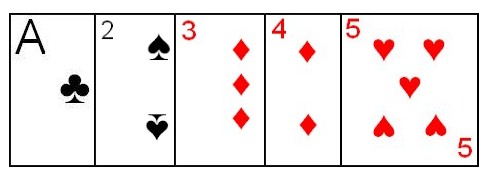 |
| When Big Two is played using Indonesian rules, Straights containing a 2 rank higher than other straights. |
Also in this variation, a straight (or straight flush) containing a 2 is considered higher ranked than any other straight which does not contain a 2. When comparing two such combinations that both contain a 2, the straights are then ranked according to the suit, using the normal suit ranking as for the standard game.
A player having only one or two cards remaining in his hand must announce this as soon as he reduces his hand to such a number of cards.
Indonesian Big Two also includes a number of scoring differences from the parent game. Players have opportunities to add and subtract points from their score during the hand and at the conclusion of each hand:
When a player manages to play the last of their cards, the remaining players are assessed a penalty
dependent on the specific ranks of the unplayed cards in their hand as well as the number of cards still in their hand. The cards from 3 to A each add 1 point to that players score. Every two remaining in the hand scores five points for that player.
This penalty is doubled if the retains 11 or 12 cards in their hand. It is tripled if they retain all 13 cards still in their hand.
The last combination played by the Winner of the hand (which causes him to run out of cards) also provides an opportunity to reduce his score. Each two used in that last combination allows the player to subtract 10 points form his score. If his last, winning, combination contains no 2's he still scores -5 points.
Lastly, there are special combinations that when played and not beaten, allow the player to subtract points from his score.
- Four twos: Four twos allows the player to subtract 80 points from their current score. If played as their last combination (which causes them to run out of cards) they score -160 instead.
- Four of a Kind (non twos): If a player plays a four of a kind (not consisting of twos) and no other player can beat it, the player who plays the four of a kind instantly subtracts 20 points from their current score. If the player plays this as their last combination before they run out of cards and win the hand, they instead subtract 40 points from their current score.
- Straight Flush: If a player manages to play a Straight Flush which is not beaten by any other player, he instantly subtracts 40 points from his current score. If the player manages to play the combination when he runs out of cards, he subtracts 80 from his score instead.
At the conclusion of the 10 deals or rounds, the player with the lowest score is declared the winner of the game.
Partnership Big Two: This version is designed for four players playing in two partnerships. Thus, the players are grouped into partnerships consisting of two players each. The partners should sit at the table in such a manner that play to the tricks alternates between members of the partnerships. The game is played identically to standard Big Two, with a few exceptions. When a player is the first to run out of cards during the hand, the game ends and the number of cards in each players hand is totaled. The team with the fewest total cards in their combined hands is declared the winner. Partners may not consult on the quality of their hands or what cards to play. If, at the end of a game both teams are tied, an abbreviated version of the game is played through multiple hands until the tie is broken. Thus, five card hands are distributed to the player and the game proceeds as normal, albeit with hands consisting of fewer cards. The player having the lowest card in their hand begins play. These abbreviated hands can continue as long as the number of cards in each partnership remains tied at the end of a hand. Once one team has fewer total remaining cards at the end of a hand, that team is declared the winner.
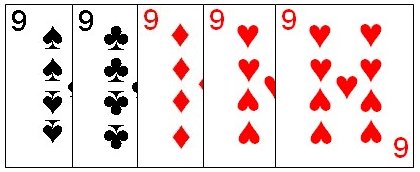 Double Deck Big Two
Double Deck Big Two: Big two can also be played in larger groups of 8 players using a double deck (two standard 52 card decks). The rules are identical to the standard rules, save for the fact that one new type of five card combination is possible. With more cards of each denomination now found in this double deck, a five card combination consisting of five identically ranked cards is added. This combination is considered the highest five card combination. When comparing two combinations of five identical cards, the five of a kind in a higher denomination is considered the higher. Also, because there are two cards of each suit in the deck used in this variation, equal combinations could be made, but, as in the standard game, in order to beat another combination a combination must be higher in some aspect.
Winner (Zheng Shangyou): Winner (also known as Zheng Shangyou) appears to be the root game from which Big Two, Tien-Len, President and
many similar games were originally created.
Winner is played very similarly to Big Two, with the following key differences:
- Winner uses one standard 52 card deck with the addition of two Jokers. These Jokers should be distinguishable in some way (such as a color and black-and-white Joker). The ranking of the cards in the deck for this game are as follows (from highest to lowest): Color Joker, Black-and-White Joker, 2, Ace, King, Queen, Jack, 10, 9, 8, 7, 6, 5, 4, 3. As in most other games of this type, the suits also have a ranking which is the same as in Big Two, from high to low: (Spades, Hearts, Clubs, Diamonds).
- The playable combinations in the game Winner is slightly different than that of Big Two. The following shows the complete list of combinations which can be led in Winner:
| Number of Cards in Combination | Description | Example |
|---|
| 1 | A single card combination consists of just one card. These uses the ranking of cards as described above for comparisons. A card of the same denomination but a higher ranking suit will beat a card of the same denomination of a lower ranking suit. |  |
| 2 | Pairs. This two-card combinations always consist of a pair of cards of the same denomination. A pair of higher denomination cards will beat that of a lower denomination. A second pair of the same denomination can beat the previously played pair if one of its cards is of the suit of spades (the highest ranked suit). |  |
| 3 | Triplet. This will always consist of three cards of the same denomination. Three cards of a higher denomination beat a triplet of a lower denomination. |  |
| 4 (or More) | Multiple Pairs. This type of combinations always consist of two or more pairs of cards. Each pair must consist of two cards of the same denomination, however each pair must be in direct, sequential order from the previous pair (i.e. 8, 8, 9, 9, 10, 10). In order to be considered higher (and a legal play), subsequent players must play a pairs combination consisting of the same number of cards, but with at least one higher ranking pair in the sequence of pairs. A second pair of the same denomination can beat the previously played pair if one of its cards is of the suit of spades (the highest ranked suit). | 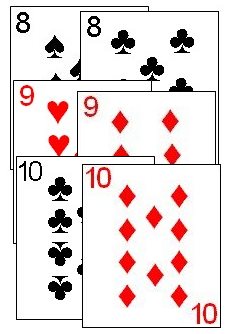 |
| 5 | Full House. A full house is a five card play which consists of three of a kind and a pair. A full house can beat a previous full house if the three of a kind is higher than the three of a kind in the previous full house. |  |
| 5 (or more) | Straight. A straight consists of five or more cards in consecutive ascending sequence (i.e. 8, 9, 10, Jack, Queen, King). The cards do not have to all be in the same suit, as if they are, this would be considered a higher ranking combination of a straight flush. In order to beat another straight a straight must contain a higher denomination card. A straight containing all of the same ranked cards can also beat a previous straight if the suit of the highest ranked card in the suit is of a higher ranked suit. Aces can be used as either the top card of a straight (10, Jack, Queen, King, Ace) or the bottom card of a straight (Ace, 2, 3, 4, 5). Notice also that twos appear in their normal ordering before the 3 if used in a straight. |  |
| 5 (or more) | Straight Flush. A straight flush is five or more sequential cards, all of the same suit (i.e. 5, 6, 7, 8, and 9, all of hearts). When comparing two such straight flushes, the one containing the highest card is considered the higher ranked. If two straight flushes contain the exact same denomination cards, the one in a higher ranked suit is considered the higher straight flush. |  |
| 4 | Four of a Kind (also called a Bomb). This combination consists of four cards of the exact same rank. When comparing a similar combination, the higher denomination four of a kind is considered to be of a higher ranking. | 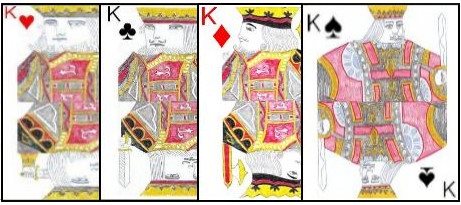 |
As in Big Two, if the lead card is of a specific type and number of cards, it can only be beat by a combination of the same type and number of cards but of a higher ranking. The exceptions to this are the Bomb (Four of a Kind) and the Straight Flush. A Four of a Kind can be used by any player on his turn to beat any play on his turn except a higher ranked Bomb or a Straight Flush. Similarly, a Straight Flush combination can be used by a player on his turn to beat any other combination except a higher ranked Straight Flush.
- A round ends when all but one player have passed after the last legal play. The player making that last play then begins the next round with any legal combination of his choice from his hand.
- The game continues until all but one player has managed to shed all his cards. The first player to have shed his cards is the Winner and the last player to have cards remaining is considered to have lost the game.
- On the next hand, the player who is considered to have lost the previous game shuffles and deals on the next hand. In addition, this player must pass his highest ranked card from his hand (face-up) to the Winner of the last hand. The Winner then passes any two cards of his choice face-up to that player. That player then selects one of the two cards and the Winner replaces the other back into his hand.
- The player who has the three of diamonds in hand makes the first player but is not required to use the three of diamonds in his first play.
- Play of the hand usually rotates in a clockwise direction when playing this game.
In all other aspects the game is played identically to Big Two.
Capsa Banting: Capsa Banting is a game which is played very similarly to Big Two and which is a variant of the game often encountered in many parts of Indonesia. The game is played largely the same as Big Two with the difference that Capsa Banting includes the addition of several special extra powerful combinations to the game, called Bombs, which can be used to beat a two.
Thus, in this Capsa Banting the special combinations of a straight flush (five cards, in direct sequential order and all of the same suit) or a four of a kind (four cards all of the exact same rank) can be used to beat a single two played by a previous player to the table.
Other than this difference, in all other aspects Capsa Banting is otherwise played identically to standard Big Two.
Big Three: Despite it's name and similar gameplay, Big Three is actually more closely aligned with games such as Dou Di Zhu. Thus, the rules for the game Big Three can be found on this
page which includes the instructions for playing Dou Di Zhu and it's variants.
Copyright © 2015
CatsAtCards.com. All rights reserved.
 Big Two is an exciting game for four players which originated in China and quickly spread around the world due to its fun and addicting gameplay.
There are also variations of Big Two for 2 or 3 players described in the variations section below, along with a number of other changes or versions of Big 2 that may be encountered.
As this game has spread rapidly and is played in a great number of different locales (such as in the Netherlands as Sjalaliién), it is also found by a number of different names including Big Deuces, Da Lao Er, Top Dog, Sho Tai Ti, and Choh Dai Di.
Big Two is an exciting game for four players which originated in China and quickly spread around the world due to its fun and addicting gameplay.
There are also variations of Big Two for 2 or 3 players described in the variations section below, along with a number of other changes or versions of Big 2 that may be encountered.
As this game has spread rapidly and is played in a great number of different locales (such as in the Netherlands as Sjalaliién), it is also found by a number of different names including Big Deuces, Da Lao Er, Top Dog, Sho Tai Ti, and Choh Dai Di.











 Big Two for Three: Big Two is also widely played with three players in a variation similar to that for two players. When three participants are playing, each player would receive 17 cards and the last card is dealt face up to the center of the table. Whichever player holds the three of diamonds would then take this card up into their hand. If that last card happens to be the three of diamonds, the holder of the three of clubs would take the card. The player taking this card would then start by making the first play (which must include the three of diamonds). The remainder of the rules are identical to the standard four hand game including in the scoring. If a player has more than 13 cards remaining in his hand when the winner of the hand plays his last card, he would be assessed a penalty of 3 points.
Big Two for Three: Big Two is also widely played with three players in a variation similar to that for two players. When three participants are playing, each player would receive 17 cards and the last card is dealt face up to the center of the table. Whichever player holds the three of diamonds would then take this card up into their hand. If that last card happens to be the three of diamonds, the holder of the three of clubs would take the card. The player taking this card would then start by making the first play (which must include the three of diamonds). The remainder of the rules are identical to the standard four hand game including in the scoring. If a player has more than 13 cards remaining in his hand when the winner of the hand plays his last card, he would be assessed a penalty of 3 points.
 Quads: In some versions of Big Two, quads are played without the addition of the fifth odd card. Thus, a new, four card combination is added to the game. A quad is four cards of the same denomination. A quad of four higher ranked cards will beat one consisting of four lower ranked cards. Usually when this variation is played, the five card combination containing a quad is removed.
Quads: In some versions of Big Two, quads are played without the addition of the fifth odd card. Thus, a new, four card combination is added to the game. A quad is four cards of the same denomination. A quad of four higher ranked cards will beat one consisting of four lower ranked cards. Usually when this variation is played, the five card combination containing a quad is removed.



